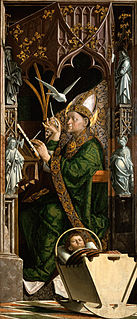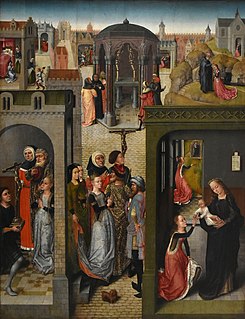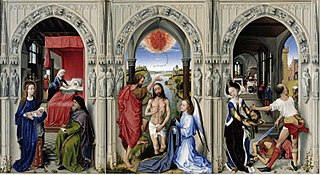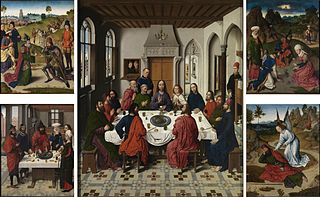
The Holy Grail is a treasure that serves as an important motif in Arthurian literature. Different traditions describe it as a cup, dish or stone with miraculous powers that provide happiness, eternal youth or sustenance in infinite abundance, often in the custody of the Fisher King. The term "holy grail" is often used to denote an elusive object or goal that is sought after for its great significance.

Bernard van Orley, also called Barend or Barent van Orley, Bernaert van Orley or Barend van Brussel, was a versatile Flemish artist and representative of Dutch and Flemish Renaissance painting, who was equally active as a designer of tapestries and, at the end of his life, stained glass. Although he never visited Italy, he belongs to the group of Italianizing Flemish painters called the Romanists, who were influenced by Italian Renaissance painting, in his case especially by Raphael.

The Garden of Earthly Delights is the modern title given to a triptych oil painting on oak panel painted by the Early Netherlandish master Hieronymus Bosch, between 1490 and 1510, when Bosch was between 40 and 60 years old. It has been housed in the Museo del Prado in Madrid since 1939.

Dieric Bouts was an Early Netherlandish painter.

Michael Pacher was a painter and sculptor from Tyrol active during the second half of the fifteenth century. He was one of the earliest artists to introduce the principles of Renaissance painting into Germany. Pacher was a comprehensive artist with a broad range of sculpting, painting, and architecture skills producing works of complex wood and stone. He painted structures for altarpieces on a scale unparalleled in North European art.
Francesco di Giovanni Botticini, commonly referred to as Francesco Botticini, was an Italian Early Renaissance painter. He was born in Florence and remained active as a painter until his death in 1498. He studied in the workshops of Neri di Becci, Cosimo Rosselli and Andrea del Verrocchio. He established his own Florentine workshop after a brief period as Neri di Bicci's assistant. Although there are few works attributed to Botticini directly, in recent years historians have unearthed of a considerable number of works that were certainly authored by Botticini. Since the assembly of the complete record of his works, he is viewed as a remarkable minor master of Renaissance Art.

Saint Peter's Church in Leuven, Belgium, is on the city's Grote Markt, opposite the ornate Town Hall. Built mainly in the 15th century in Brabantine Gothic style, the church has a cruciform floor plan and a low bell tower that has never been completed. It is 93 metres (305 ft) long.

The Last Supper of Jesus and the Twelve Apostles has been a popular subject in Christian art, often as part of a cycle showing the Life of Christ. Depictions of the Last Supper in Christian art date back to early Christianity and can be seen in the Catacombs of Rome.

The Fiesole Altarpiece is a painting by the Italian early Renaissance master Fra Angelico, executed around 1424–1425. It is housed in the Convent of San Domenico, Fiesole, central Italy. The background was repainted by Lorenzo di Credi in 1501.

Triptych of the Annunciation is a 1483 triptych by the Flemish artist known only as the Master of the Legend of Saint Ursula, located in the Indianapolis Museum of Art, which is in Indianapolis, Indiana. It depicts the Annunciation on the central panel, while the surrounding panels and the outside of the wings are covered in various pairs of male saints.

Aert van den Bossche or the Master of the Crispinus and Crispinianus-Legend was an Early Netherlandish painter of altarpieces, active in Brussels and Bruges in the late 15th century. There is still doubt as to whether he should be identified with the Master of the legend of St. Barbara or was only one of the artists active in a workshop responsible for the works of that master.

The Triptych of Temptation of St. Anthony is an oil painting on wood panels by the Early Netherlandish painter Hieronymus Bosch, dating from around 1501. The work tells the story of the mental and spiritual torments endured by Saint Anthony the Great, one of the most prominent of the Desert Fathers of Egypt in the late 3rd and early 4th centuries. The Temptation of St. Anthony was a popular subject in Medieval and Renaissance art. In common with many of Bosch's works, the triptych contains much fantastic imagery. The painting hangs in the Museu Nacional de Arte Antiga in Lisbon.

The Aachen Altar or Passion Altar (Passionsaltar) is a late gothic passion triptych in the Aachen Cathedral Treasury, made by the so-called Master of the Aachen Altar around 1515/20 in Cologne, Germany.

The Master of the Legend of Saint Catherine is the Notname for an unknown late 15th century Early Netherlandish painter. He was named after a painting with Scenes from the Legend of Saint Catherine, now kept in the Royal Museums of Fine Arts of Belgium. He was active between c. 1470 and c. 1500, probably around Brussels.

The St John Altarpiece is a c. 1455 oil-on-oak wood panel altarpiece by the Early Netherlandish painter Rogier van der Weyden, now in the Gemäldegalerie, Berlin. The triptych is linked to the artist's earlier Miraflores Altarpiece in its symbolic motifs, format and intention.

Altarpiece of the Holy Sacrament or Triptych of the Last Supper is a 1464–1468 dated triptych attributed to Dieric Bouts, now reassembled and held at its location of origin at St. Peter's Church, Leuven.

The Pesaro Altarpiece is an oil on panel painting by Giovanni Bellini, dated to some time between 1471 and 1483. It is considered as one of Bellini's first mature works, though there are doubts on its dating and on who commissioned it. The work's technique is not only an early use of oils but also of blue smalt, a by-product of the glass industry. It had already been used in the Low Countries in Bouts' 1455 The Entombment, but this marked smalt's first use in Italian art, twenty years before Leonardo da Vinci used it in Ludovico il Moro's apartments in Milan in 1492. Bellini also uses the more traditional lapis lazuli and azurite for other blues in the work.
The Edelheere Altarpiece is the first of many copies of the Descent from the Cross painted by Rogier van der Weyden around 1435. A total of fifty copies of Van de Weyden's work are known. The Edelheere triptych was made in 1443 for the St. Peter's Church in Leuven by an unknown artist, and it was commissioned by Willem Edelheere from Leuven.
Jan Rombouts was a painter from Leuven, Belgium who had started as a student of Dirk Bouts. Together with Albrecht Bouts, the son of Dirk Bouts, he managed the clerk chapel. In addition, from 1519 until his death in 1535, he continuously held the position of dean in the city council. Two of his works have been preserved in the Saint Peter's Church in Leuven, namely The Martyrdom of St. Clement and The Martyrdom of St. Catherine.
In the choir of the St. Peter's Church in Leuven is a twelve-meter high sacrament tower designed by architect Matheus de Laeyens from 1450. It was ordered by the Brotherhood of the holy Sacrament. Sacrament towers were frequently built from the mid-15th century. This are tabernacles in the shape of a tower, in which the sacred sacrament, a host, was kept. This design was no exception: for this reason doors are provided on the choir side and in the direction of the two northern chapel chapels, which the Brotherhood of the Holy Sacrament was given in 1432 from the chapter of Saint Peter. Sacrament towers were regularly built until the 17th century. Then the Church decided that the tabernacle should be placed in the center of the altar.
















